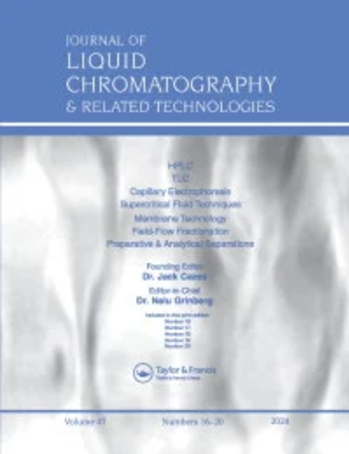快速稳定指示液相色谱法定量人唾液中咖啡因的验证与应用
IF 1.2
4区 化学
Q4 BIOCHEMICAL RESEARCH METHODS
Journal of Liquid Chromatography & Related Technologies
Pub Date : 2022-02-25
DOI:10.1080/10826076.2022.2095402
引用次数: 2
摘要
目前正在进行一项临床试验,以检查使用枸橼酸咖啡因预防晚期早产儿间歇性低氧血症的有效性。在这一人群中,使用唾液测定咖啡因浓度是可取的,因为它比血浆取样侵入性小,但需要一种合适的分析方法。本文介绍了一种快速、高效、重现性稳定的高效液相色谱(HPLC)定量测定唾液中咖啡因的方法和提取方案。测定临时制备的咖啡因柠檬酸盐溶液(20-25°C)的稳定性,以及咖啡因添加唾液样品(20-25°C和2-8°C)的稳定性,以确保所开发的方法在临床试验样品分析中的适用性。乙腈蛋白沉淀确保了唾液蛋白的完全去除,所有样品的提取回收率≥95%。提取后的HPLC检测在0.3 ~ 50 µg/mL(定量下限0.3 µg/mL)范围内呈线性(r2为0.99)。质量控制样品的准确度为94 ~ 100%,所有样品的相对标准偏差(RSD) <7%。含咖啡因的唾液样品在提取前和提取后的三次冻融循环中都是稳定的。因此,所描述的提取和高效液相色谱方法适用于拿铁剂量试验中临床试验样品的分析。所有的咖啡因溶液在物理和化学上都是稳定的,在三个月的测试期结束时,浓度在基线浓度的4%以内,表明适合用作临床试验药物。图形抽象本文章由计算机程序翻译,如有差异,请以英文原文为准。
Validation and application of a simple and rapid stability-indicating liquid chromatographic assay for the quantification of caffeine from human saliva
Abstract A clinical trial is currently underway to examine the efficacy of using caffeine citrate to prevent intermittent hypoxemia in late preterm neonates. Determining caffeine concentration using saliva in this population would be preferable as it is less invasive than plasma sampling, but a suitable method of analysis is required. This paper presents the development and validation of a rapid, efficient and reproducible stability-indicating high-performance liquid chromatography (HPLC) method and extraction protocol for the quantification of caffeine present in saliva. The stability of extemporaneously prepared caffeine citrate solutions (at 20–25 °C) was determined, along with the stability of caffeine spiked saliva samples (at 20–25 and 2–8 °C), to ensure the suitability of the developed method in the analysis of clinical trial samples. Protein precipitation using acetonitrile ensured the complete removal of salivary proteins and resulted in extraction recovery of ≥95% for all samples. The HPLC assay following extraction was linear (R 2>0.99) over the range 0.3–50 µg/mL (lower limit of quantification 0.3 µg/mL). The accuracy of the quality control samples was 94–100% and the relative standard deviation (RSD) was <7% for all samples. Caffeine-spiked saliva samples were stable for three freeze-and-thaw cycles pre-extraction and up to 72 hr post-extraction. The extraction and HPLC methods described were thus suitable for the analysis of clinical trial samples from the Latte Dosage Trial. All caffeine solutions were physically and chemically stable, with concentrations at the end of the three-month test period being within 4% of the baseline concentrations, indicating appropriateness for use as clinical trial medications. Graphical Abstract
求助全文
通过发布文献求助,成功后即可免费获取论文全文。
去求助
来源期刊
CiteScore
2.80
自引率
0.00%
发文量
29
审稿时长
4.9 months
期刊介绍:
The Journal of Liquid Chromatography & Related Technologies is an internationally acclaimed forum for fast publication of critical, peer reviewed manuscripts dealing with analytical, preparative and process scale liquid chromatography and all of its related technologies, including TLC, capillary electrophoresis, capillary electrochromatography, supercritical fluid chromatography and extraction, field-flow technologies, affinity, and much more. New separation methodologies are added when they are developed. Papers dealing with research and development results, as well as critical reviews of important technologies, are published in the Journal.

 求助内容:
求助内容: 应助结果提醒方式:
应助结果提醒方式:


